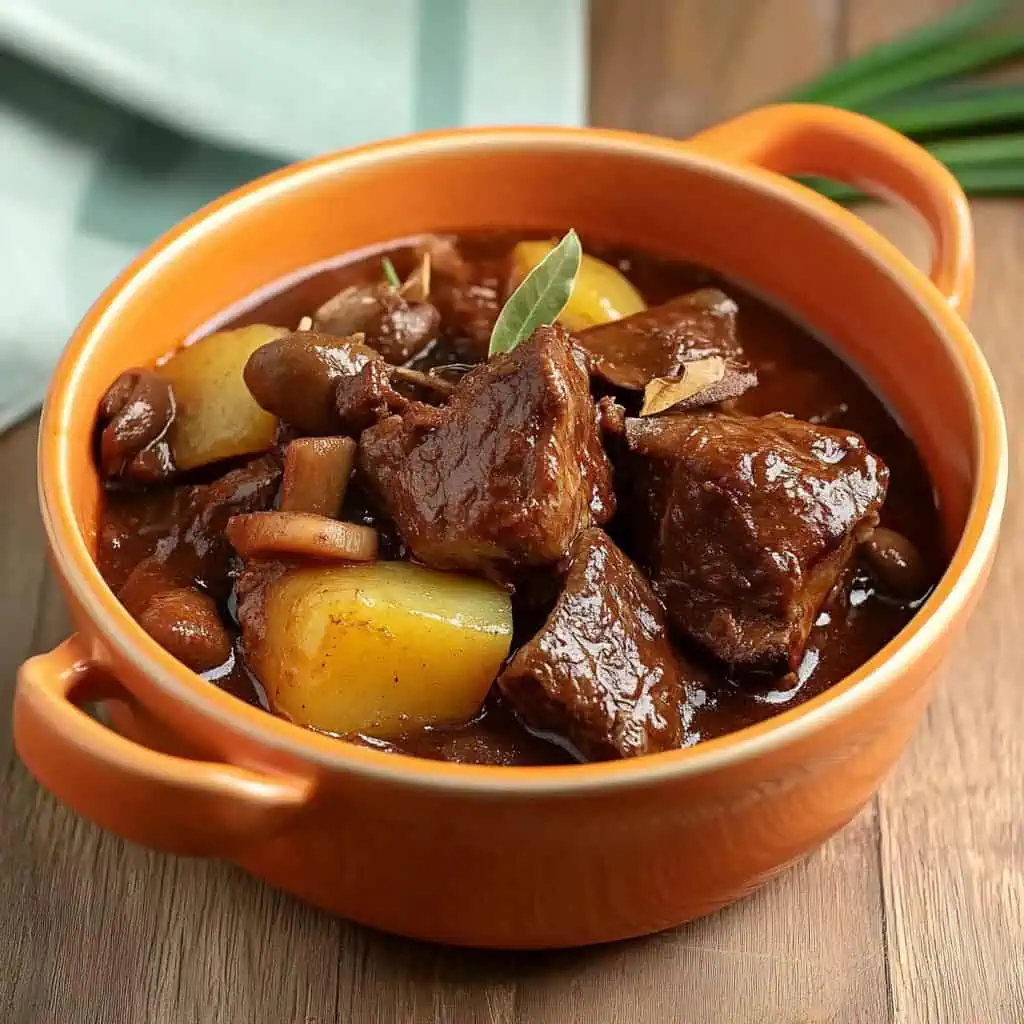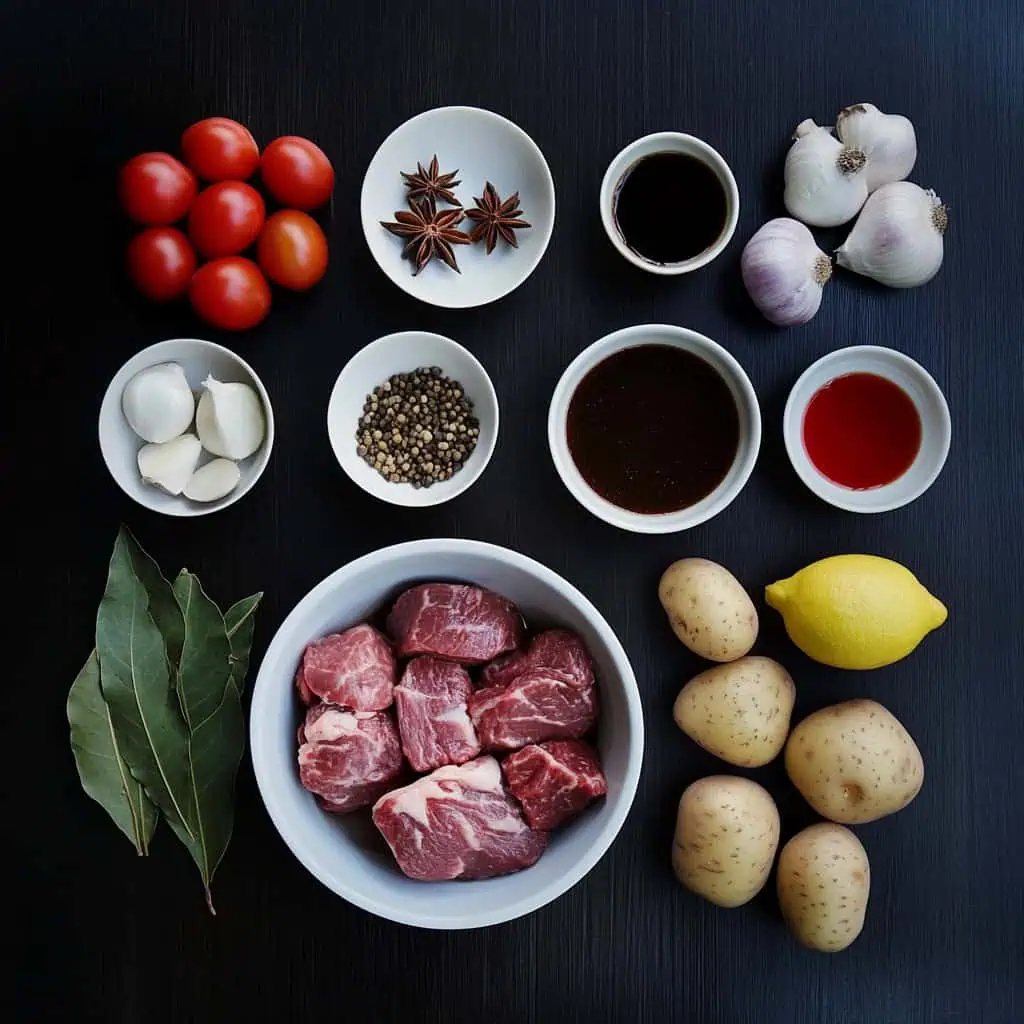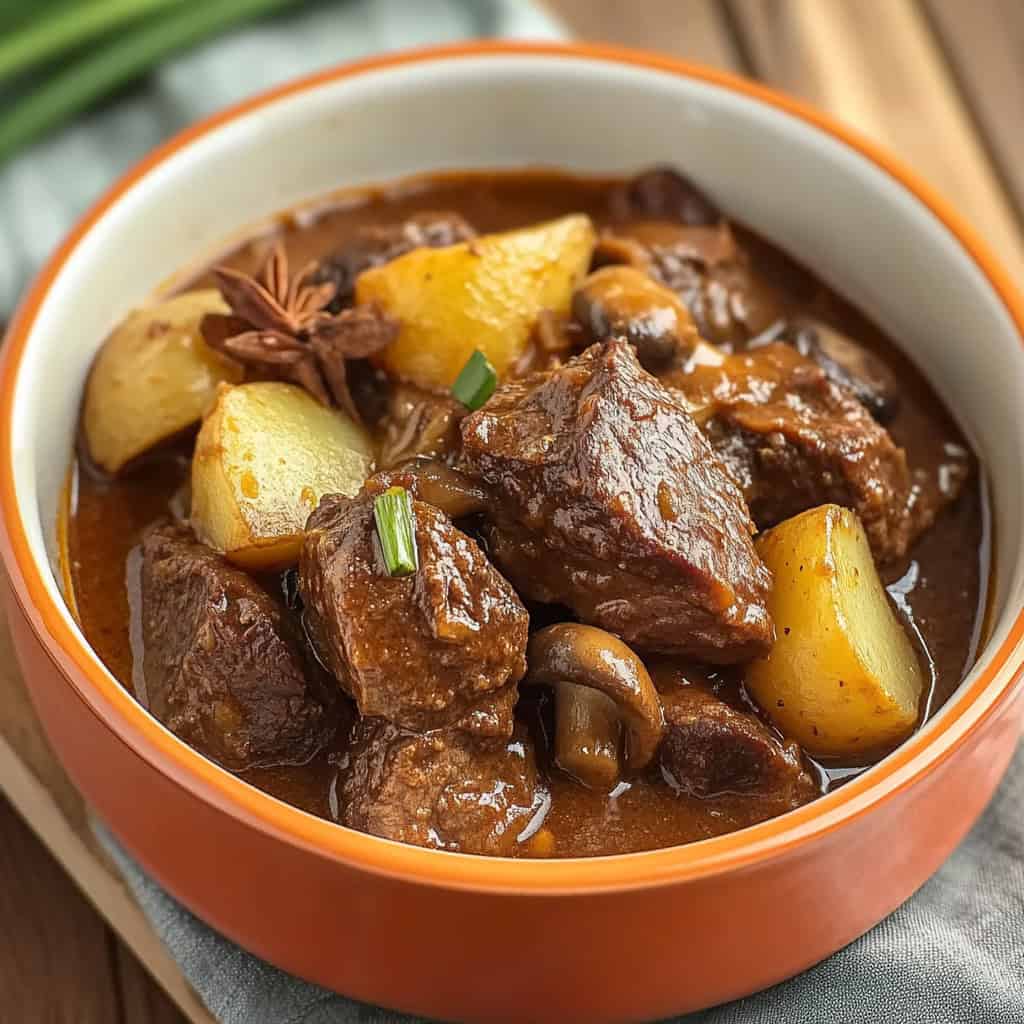Let me share a special recipe I learned during my college days in Pampanga. My Kapampangan friends had invited me over for a Sunday lunch, and that's where I first tasted their family's Manyaman Beef Asado.
This isn't your typical asado, it's a beautiful marriage of Spanish, Chinese, and Kapampangan cooking techniques that creates something entirely new. It starts with charcoal-grilled beef for that smoky flavor, then it's slowly braised in a tomato sauce that's been infused with star anise and other Chinese spices.
My friends' Lola insisted that this extra step of grilling the beef first is what makes it "manyaman" (extra delicious). After years of practice and some guidance from my Kapampangan friends, I'm excited to share their family's version of this special dish with you.
Jump to:

Why You'll Love This Recipe
- Perfect Balance of Flavors: The combination of charcoal-grilled beef, tomato-based sauce, and Chinese spices creates an unforgettable taste experience
- Restaurant-Quality: This is the same recipe served in high-end Filipino restaurants
- Make-Ahead Friendly: The flavors actually improve after a day in the refrigerator
- Special Occasion Worthy: Impressive enough for celebrations but simple enough for Sunday family meals
- One-Pot Wonder: Despite the complex flavors, most of the cooking happens in one pot
- Customizable: Can be adjusted to your preferred level of sweetness or spiciness
Ingredients
This recipe brings together the best elements of Filipino, Chinese, and Spanish cooking traditions. The well-marbled chuck steak provides the perfect texture for long braising, while star anise and bay leaves add aromatic depth. Tomatoes create the stew's rich base, balanced by soy sauce's umami and brown sugar's subtle sweetness.
The addition of mushrooms and potatoes makes this a complete one-pot meal, while the finishing touch of butter and lemon juice brightens and enriches the final dish, creating that signature "manyaman" (extraordinarily delicious) flavor that Kapampangan cuisine is known for.

- 1 kg chuck steak, well-marbled, whole or large cuts
- 2 large potatoes, cubed
- 200 g fresh white button mushrooms
- 400 g canned chopped tomatoes
- 2 tablespoon tomato paste
- 3 cups beef stock
- ¼ cup soy sauce
- 1 tablespoon cane vinegar
- Juice from ½ lemon
- 4 pcs bay leaves
- 2 teaspoon brown sugar
- 3 pcs star anise
- 1 white onion, chopped
- 6 cloves garlic, minced
- ¼ cup butter
- Freshly ground black pepper
- Salt
- Oil
Equipment
- Charcoal Grill: For achieving that essential smoky flavor - This is crucial for the authentic taste of the dish as it creates the base flavor that distinguishes this version from regular beef asado.
- Large Heavy-Bottom Pot or Dutch Oven: For slow-cooking the beef until tender - A thick-bottomed pot helps distribute heat evenly and prevents burning during the long braising process.
- Sharp Knife: For cutting the beef into uniform pieces - Even pieces ensure all the meat cooks at the same rate.
- Cutting Board: Preferably wooden for meat preparation - Wood is gentler on your knives and provides a stable surface for cutting.
- Measuring Cups and Spoons: For precise ingredient measurements - Accuracy is important for balanced flavors.
- Tongs: For handling the meat while grilling - Allows you to turn the meat safely without piercing it and losing juices.
- Wooden Spoon: For stirring without scratching the pot - Wood won't damage your cookware and is perfect for the long, slow cooking process.

How To Make
- Season the chuck steak generously with salt and freshly ground black pepper. While heating your charcoal grill to high heat (200°C/392°F), let the seasoning penetrate the meat for about 10 minutes. Once the grill is hot, grill the steak for exactly 4 minutes on each side to achieve a nice char. Remove from heat and let it rest for 5 minutes before cutting into 2-inch cubes. Save any juices that come out.
- Heat 2 tablespoons of oil in a large pot over medium heat (170°C/338°F). Add minced garlic and cook for 30 seconds until fragrant, then add chopped onions and cook for 3-4 minutes until they become clear. Add tomato paste and stir constantly for 1 minute to cook off the raw taste.
- Add the cubed beef and all the collected juices to the pot. Pour in the beef stock, chopped tomatoes, soy sauce, and vinegar. Add the bay leaves, brown sugar, and star anise. Let it come to a boil, then lower the heat (140°C/284°F) and cover the pot. Let it simmer gently for 1 hour, stirring occasionally to prevent sticking.
- After an hour, add the whole mushrooms and continue cooking for 45 minutes with the lid on. Check the liquid level every now and then – the meat should always be mostly covered. Add the cubed potatoes and butter, then cook for another 15 minutes or until you can easily pierce the potatoes with a fork.
- Turn the heat up to high and let the sauce reduce until it thickens and coats the back of your spoon. Taste and add salt and pepper as needed. Squeeze fresh lemon juice over the top and give everything a final stir. Turn off the heat and let the dish rest for 10 minutes before serving – this helps the meat soak up more flavor. Serve hot with freshly cooked rice.
Note: If you notice the sauce getting too thick at any point, add hot beef stock ¼ cup at a time. Your final sauce should be rich and thick enough to coat the meat but still be easily spooned over rice.

Tips from Lola's Kitchen
- Choose the right cut: Select beef with good marbling for the most tender result. Chuck steak works beautifully, but short ribs or brisket can also be excellent alternatives.
- Don't rush the grilling: The charcoal grilling step is crucial for the signature smoky flavor. Even if you're in a hurry, those 8 minutes (4 on each side) make all the difference.
- Sauce consistency matters: If your sauce becomes too thick during cooking, add hot beef stock ¼ cup at a time to maintain the perfect consistency.
- Overnight marination: For even more depth of flavor, marinate the beef overnight in soy sauce, minced garlic, and black pepper before grilling.
- Spice enhancement: Toast the star anise briefly in a dry pan before adding to the stew to release more of its aromatic oils.
- Timing the potatoes: Always add the potatoes last to prevent them from becoming too soft and falling apart in the stew.
- The resting period: Don't skip the 10-minute rest before serving - this allows the flavors to settle and the meat to absorb more sauce.
Substitutions
- Beef cuts: Chuck steak can be replaced with beef brisket, short ribs, or beef shanks
- Mushrooms: Fresh mushrooms can be substituted with canned mushrooms (just drain well before adding)
- Star anise: If unavailable, use Chinese five-spice powder (1 teaspoon)
- Cane vinegar: Apple cider vinegar works as an alternative
- White onion: Red onion or yellow onion will work, though white gives the most authentic flavor
- Fresh tomatoes: Canned diced tomatoes can replace fresh ones (use about 2 cups)
- Beef stock: Water mixed with beef bouillon cubes (follow cube package instructions for ratio)
- Brown sugar: Can be replaced with palm sugar or regular white sugar in a pinch
Troubleshooting
- Meat still tough after cooking? Different cuts of beef require different cooking times. Continue cooking on low heat until the meat is fork-tender, adding more stock if needed to keep the meat covered.
- Sauce too thin? Increase heat and reduce uncovered until desired thickness. For a quicker fix, mix 1 tablespoon cornstarch with 2 tablespoons cold water and stir into the simmering sauce.
- Too salty? Add a quartered potato while cooking to absorb excess salt, then remove before serving. You can also add a bit more tomato or a teaspoon of sugar to balance the saltiness.
- Too acidic? Add ½ teaspoon more brown sugar to balance the acidity from the tomatoes and vinegar.
- Too sweet? Add a splash of vinegar or fresh lemon/calamansi juice to bring back the balance.
- Burnt bottom? If you notice a burnt smell, don't scrape the bottom! Carefully transfer the contents to a new pot, leaving the burnt layer behind.
Storage & Reheating
- Refrigerator: Store in an airtight container for up to 4 days. The flavors actually improve after a day or two!
- Freezer: Freeze for up to 3 months in a freezer-safe container. Consider portioning it before freezing for easier thawing.
- Reheating on Stovetop: Thaw completely if frozen, then reheat on low heat with additional beef stock if needed. Stir occasionally to prevent sticking.
- Reheating in Microwave: Place in a microwave-safe container and heat for 2-3 minutes, stirring halfway through. Cover loosely to prevent splattering.
- Pro tip: Let come to room temperature before reheating for best results and more even warming.

FAQ
Can I make this without a charcoal grill?
Yes, you can sear the meat on a very hot cast-iron pan or broil it in your oven on high. While the smoky flavor will be less pronounced, you'll still get good caramelization. For a smoky note without grilling, you could add a drop of liquid smoke, though traditional purists might frown upon this shortcut.
Why is my beef still tough after cooking?
Different cuts and qualities of beef require different cooking times. Continue cooking until the meat is fork-tender. The connective tissue in chuck steak needs time to break down into gelatin, which happens at a low temperature over a long period. Patience is key here!
Can I use a pressure cooker or Instant Pot?
Absolutely! After grilling and sautéing as directed, pressure cook on high for about 35-40 minutes with a natural release. Add the potatoes afterward and simmer until tender. The sauce may need additional reducing after pressure cooking.
Is this recipe freezer-friendly?
Yes, it freezes beautifully for up to 3 months. The flavors actually continue to develop, though the potatoes might change texture slightly. Consider freezing before adding potatoes and adding freshly cooked ones when reheating.
Can I make this ahead for a party?
This is perfect for make-ahead meals! It actually tastes better after a day or two in the refrigerator as the flavors continue to meld. Simply reheat gently before serving, adding a splash of beef stock if needed to loosen the sauce.
How can I make this dish spicy?
While not traditional, you can add 2-3 Thai chilies or 1 tablespoon of chili garlic sauce during the braising process. Some families do make a spicier version, particularly those with Chinese heritage influences.
What can I serve with Manyaman Beef Asado?
Traditionally, it's served with steamed white rice, but it also pairs wonderfully with garlic rice (sinangag). Side dishes might include pickled papaya (atchara), steamed vegetables, or a simple tomato and onion salad dressed with calamansi juice.
Can I use this recipe for special occasions?
Absolutely! This dish is perfect for special gatherings and celebrations. The complex flavors and tender beef make it impressive enough for important occasions, but it's also simple enough for Sunday family meals.
Related
Looking for other recipes like this? Try these:

Manyaman Beef Asado (Kapampangan-Style Tomato-Braised Beef)
Equipment
- Charcoal Grill: For achieving that essential smoky flavor (Ihawan/Grill)
- Large Heavy-Bottom Pot or Kaldero: For slow-cooking the beef until tender
- Sharp Knife: For cutting the beef into uniform pieces
- Cutting Board: Preferably wooden for meat preparation
- Measuring Cups and Spoons: For precise ingredient measurements
- Tongs: For handling the meat while grilling
- Wooden Spoon: For stirring without scratching the pot (Sandok na Kahoy)
Ingredients
- 1 kg chuck steak Litid ng Baka, well-marbled, whole or large cuts
- 2 large potatoes Patatas, cubed
- 200 g fresh white button mushrooms Kabute
- 400 g canned chopped tomatoes
- 2 tablespoon tomato paste
- 3 cups beef stock
- ¼ cup soy sauce Toyo
- 1 tablespoon cane vinegar Suka
- Juice from ½ lemon
- 4 pcs bay leaves Dahon ng Laurel
- 2 teaspoon brown sugar Maskobado
- 3 pcs star anise
- 1 white onion chopped (Sibuyas)
- 6 cloves garlic minced (Bawang)
- ¼ cup butter Mantikilya
- Freshly ground black pepper Paminta
- Salt Asin
- Oil Mantika
Instructions
- Season the chuck steak generously with salt and freshly ground black pepper. While heating your charcoal grill to high heat (200°C/392°F), let the seasoning penetrate the meat for about 10 minutes. Once the grill is hot, grill the steak for exactly 4 minutes on each side to achieve a nice char. Remove from heat and let it rest for 5 minutes before cutting into 2-inch cubes. Save any juices that come out.
- Heat 2 tablespoons of oil in a large pot over medium heat (170°C/338°F). Add minced garlic and cook for 30 seconds until fragrant, then add chopped onions and cook for 3-4 minutes until they become clear. Add tomato paste and stir constantly for 1 minute to cook off the raw taste.
- Add the cubed beef and all the collected juices to the pot. Pour in the beef stock, chopped tomatoes, soy sauce, and vinegar. Add the bay leaves, brown sugar, and star anise. Let it come to a boil, then lower the heat (140°C/284°F) and cover the pot. Let it simmer gently for 1 hour, stirring occasionally to prevent sticking.
- After an hour, add the whole mushrooms and continue cooking for 45 minutes with the lid on. Check the liquid level every now and then – the meat should always be mostly covered. Add the cubed potatoes and butter, then cook for another 15 minutes or until you can easily pierce the potatoes with a fork.
- Turn the heat up to high and let the sauce reduce until it thickens and coats the back of your spoon. Taste and add salt and pepper as needed. Squeeze fresh lemon juice over the top and give everything a final stir. Turn off the heat and let the dish rest for 10 minutes before serving – this helps the meat soak up more flavor. Serve hot with freshly cooked rice.
- Note: If you notice the sauce getting too thick at any point, add hot beef stock ¼ cup at a time. Your final sauce should be rich and thick enough to coat the meat but still be easily spooned over rice.
Tips from Lola's Kitchen
- Choose beef with good marbling for the most tender result
- Don't skip the charcoal grilling step - it's crucial for the signature smoky flavor
- If sauce becomes too thick, add hot beef stock ¼ cup at a time
- For extra flavor, marinate the beef overnight in soy sauce, garlic, and black pepper
- Toast the star anise briefly before adding to release more flavor
- Add the potatoes last to prevent them from becoming too soft
Nutrition
The Story Behind Manyaman Beef Asado
In the heart of Pampanga, where the Philippines' most treasured recipes are born, Manyaman Beef Asado stands as a testament to the region's rich culinary legacy. The word "manyaman" itself carries special weight in Kapampangan cuisine – it's their term for "masarap" or "delicious," but it means so much more. When Kapampangans add "manyaman" to a dish's name, they're signaling something exceptional, a version that goes beyond the ordinary.
This particular beef asado tells the story of Filipino cuisine's multicultural roots. While the Spanish colonizers brought their tradition of grilling meats (asado), and the Chinese merchants introduced their sweet-savory braising techniques with star anise and soy sauce, it was the Kapampangans who masterfully wove these influences together with their signature tomato-based stewing method. The result is a dish that speaks of centuries of cultural exchange and culinary innovation.
What makes Pampanga's version unique is the crucial first step of charcoal grilling the beef before braising – a technique that elevates the dish from good to extraordinary. This extra effort creates layers of flavor that you won't find in other regional variations. Local cooks will tell you that this method was born from the Kapampangan's relentless pursuit of flavor, their understanding that a few extra steps can transform a simple beef stew into something worthy of special occasions.
Each Kapampangan household may have its own closely guarded version of this recipe, passed down through generations. Some families might increase the star anise for a stronger Chinese influence, while others might lean into the Spanish roots with more tomatoes and garlic. But all versions share that distinctive smoky-sweet-savory profile that makes people nod in understanding when they hear the word "manyaman" attached to its name.
Today, Manyaman Beef Asado remains a fixture at Kapampangan family gatherings, Sunday lunches, and fiestas. It represents not just a dish, but the pride of a region famous for elevating Filipino cuisine to new heights. When you taste the tender beef, enriched by the complex sauce that carries hints of smoke, tomatoes, and Chinese spices, you're experiencing a piece of living culinary history – one that continues to evolve while staying true to its roots in the cooking capital of the Philippines.










Comments
No Comments